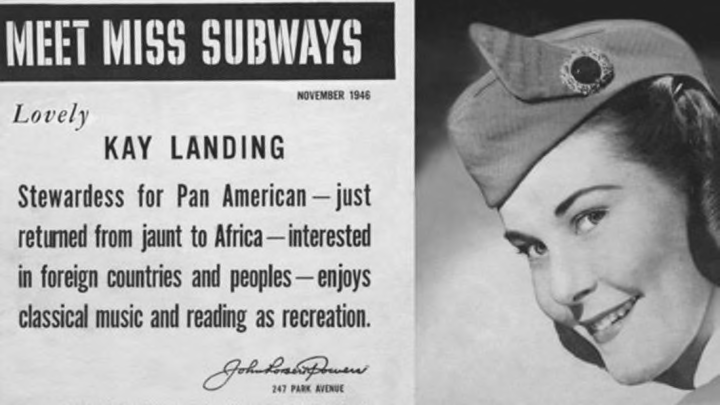Riding the subway was an entirely different experience 75 years ago—and not just because the cars weren’t air-conditioned. From 1941 to 1976, commuters rode in the company of esteemed pageant winners known "Miss Subways."
The Miss Subways contest was sponsored by the New York Subways Advertising company. Every few months or so, a new woman was crowned and photographed by the John Robert Powers modeling agency. Posters with the reigning winner's image would then be plastered on subway cars and buses, along with a short description to be seen by every public transit rider in the city.
In order to qualify for the Miss Subways crown, candidates needed to meet two basic requirements: They had to live in New York City and regularly use the subway. The more nitty-gritty rules stipulated that a participant also had to be between 14 and 30 years old, and couldn’t be a professional model or actress. Still, that didn't mean they didn't have A-list charisma. As Peggy Byrne, one of the 1952 Miss Subways, told Radio Diaries, "When you looked at Miss Subways, you were looking at a star, no question about it."
Initially, John Robert Powers himself picked the winners, but in later years contestants’ photos were posted in the subway cars and commuters could vote by postcard (and later telephone) for the next winner. Once elected, Miss Subways represented the city at various functions. In this 1962 photo, for example, selectee Sally Pishney fulfilled her duties by accompanying representatives of a Japanese traffic survey during a tour. Such was the life of a NYC transit poster girl.
Despite the more problematic aspects inherent to any beauty contest, Miss Subways could be a force for good. In 1948, Thelma Porter was chosen as the first African-American Miss Subways, a whole 36 years before Vanessa Williams would be crowned the first black Miss America.
Photographer Fiona Gardner (who, along with journalist Amy Zimmer, collected the winners’ stories in a book called Meet Miss Subways: New York’s Beauty Queens 1941-76) told the Associated Press in 2012: "It was the first integrated and ethnically diverse beauty contest in America. I realized I had stumbled on a piece of forgotten New York history."
What Miss Subways did share with Miss America was a certain element of sexism. The poster for the Miss Subways of July 1946, for example, proclaimed that Enid Berkowitz "was plugging for [a] B.A., but would settle for an M.R.S."
Many took that Bachelor's degree and went even further. The campaign produced more than 200 Miss Subways in its run, and the winners went on to accomplish a wide variety of notable career achievements—from law degrees to positions in the CIA.
While not all stayed famous beyond their 15 minutes as Miss Subways, some women did end up in Tinseltown. The very first Miss Subways, Mona Freeman, was discovered and signed by Howard Hughes. She went on to star in movies like Till We Meet Again, Black Beauty, Angel Face, and Jumping Jacks (with Dean Martin and Jerry Lewis). The contest itself also got some screen treatment (of sorts): It was immortalized in Leonard Bernstein’s 1944 Broadway musical, On the Town, which featured a character who was the current Miss Turnstiles.
"Miss Subways is a little-known gem of New York history," Gardner told DNA Info. "And the women chosen are incredibly inspiring and have lived full and successful lives."
